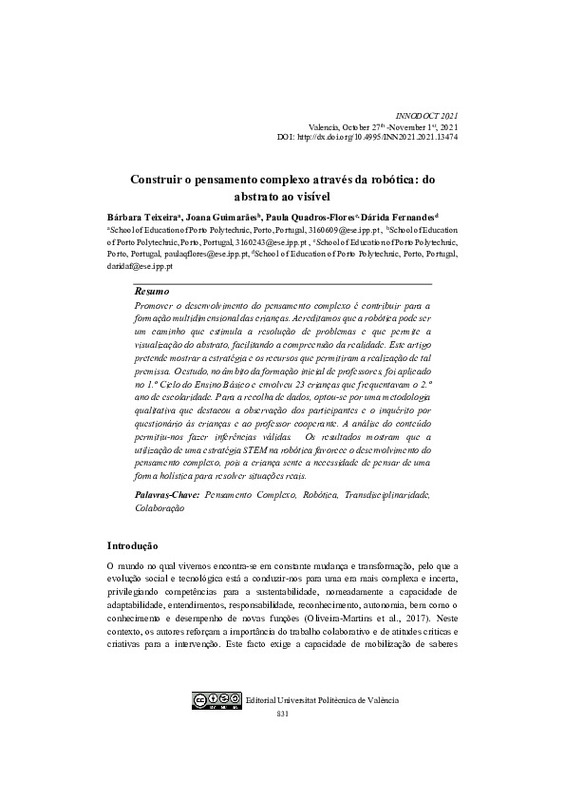JavaScript is disabled for your browser. Some features of this site may not work without it.
Buscar en RiuNet
Listar
Mi cuenta
Estadísticas
Ayuda RiuNet
Admin. UPV
Construir o pensamento complexo através da robótica: do abstrato ao visível
Mostrar el registro sencillo del ítem
Ficheros en el ítem
| dc.contributor.author | Teixeira, Bárbara
|
es_ES |
| dc.contributor.author | Guimarães, Joana
|
es_ES |
| dc.contributor.author | Quadros-Flores, Paula
|
es_ES |
| dc.contributor.author | Fernandes, Dárida
|
es_ES |
| dc.date.accessioned | 2022-10-25T10:35:58Z | |
| dc.date.available | 2022-10-25T10:35:58Z | |
| dc.date.issued | 2022-01-19 | |
| dc.identifier.isbn | 9788490483657 | |
| dc.identifier.uri | http://hdl.handle.net/10251/188670 | |
| dc.description.abstract | [EN] Promoting the development of complex thinking helps children to face challenges of today. We believe that robotics can be a path that stimulates problem solving and allows the visualization of the abstract in a real environment, facilitating the understanding of reality and the development of complex thinking. In this sense, this article aims to show the strategy and resources that allowed to realize such premise. The study was applied in the 1st Cycle of Basic Education and involved 23 children attending the 2nd year of schooling. For data collection, a qualitative methodology based on participant observation and interview survey was chosen. Content analysis allows us to formulate valid inferences. The results reveal that STEAM is a strategy that allows the articulation between the areas of Science (S), Technology (T), Engineering (E), Arts (A) and Mathematics (M), as well as robotics. In this specific case, the Blue Bot was a resource that allowed the visualization of mathematical formulas imagined by the children, in teams, based on the curricular contents of mathematics and environmental studies. The communication of the formulas in the challenge to other groups allowed the development of the mother tongue and discursive logic reasoning. | es_ES |
| dc.description.abstract | [PT] Promover o desenvolvimento do pensamento complexo é contribuir para a formação multidimensional das crianças. Acreditamos que a robótica pode ser um caminho que estimula a resolução de problemas e que permite a visualização do abstrato, facilitando a compreensão da realidade. Este artigo pretende mostrar a estratégia e os recursos que permitiram a realização de tal premissa. O estudo, no âmbito da formação inicial de professores, foi aplicado no 1.º Ciclo do Ensino Básico e envolveu 23 crianças que frequentavam o 2.º ano de escolaridade. Para a recolha de dados, optou-se por uma metodologia qualitativa que destacou a observação dos participantes e o inquérito por questionário às crianças e ao professor cooperante. A análise do conteúdo permitiu-nos fazer inferências válidas. Os resultados mostram que a utilização de uma estratégia STEM na robótica favorece o desenvolvimento do pensamento complexo, pois a criança sente a necessidade de pensar de uma forma holística para resolver situações reais. | es_ES |
| dc.description.sponsorship | Este trabalho é financiado por fundos nacionais através da FCT - Fundação para a Ciência e Tecnologia, I.P., no âmbito do projecto UIDB/05198/2020 (Centro de Investigação e Inovação na Educação, inED). | es_ES |
| dc.format.extent | 9 | es_ES |
| dc.language | Portugués | es_ES |
| dc.publisher | Editorial Universitat Politècnica de València | es_ES |
| dc.relation.ispartof | Proceedings INNODOCT/21. International Conference on Innovation, Documentation and Education | |
| dc.rights | Reconocimiento - No comercial - Compartir igual (by-nc-sa) | es_ES |
| dc.subject | Complex Thinking | es_ES |
| dc.subject | Robotics | es_ES |
| dc.subject | Transdisciplinarity | es_ES |
| dc.subject | Collaboration | es_ES |
| dc.subject | Pensamento Complexo | es_ES |
| dc.subject | Robótica | es_ES |
| dc.subject | Transdisciplinaridade | es_ES |
| dc.subject | Colaboração | es_ES |
| dc.title | Construir o pensamento complexo através da robótica: do abstrato ao visível | es_ES |
| dc.type | Capítulo de libro | es_ES |
| dc.type | Comunicación en congreso | es_ES |
| dc.identifier.doi | 10.4995/INN2021.2021.13474 | |
| dc.relation.projectID | info:eu-repo/grantAgreement/FCT//UIDB%2F05198%2F2020 | es_ES |
| dc.rights.accessRights | Abierto | es_ES |
| dc.description.bibliographicCitation | Teixeira, B.; Guimarães, J.; Quadros-Flores, P.; Fernandes, D. (2022). Construir o pensamento complexo através da robótica: do abstrato ao visível. En Proceedings INNODOCT/21. International Conference on Innovation, Documentation and Education. Editorial Universitat Politècnica de València. 831-839. https://doi.org/10.4995/INN2021.2021.13474 | es_ES |
| dc.description.accrualMethod | OCS | es_ES |
| dc.relation.conferencename | INNODOCT 2021 | es_ES |
| dc.relation.conferencedate | Octubre 27-Noviembre 01, 2021 | es_ES |
| dc.relation.conferenceplace | Valencia, España | es_ES |
| dc.relation.publisherversion | http://ocs.editorial.upv.es/index.php/INNODOCT/INN2021/paper/view/13474 | es_ES |
| dc.description.upvformatpinicio | 831 | es_ES |
| dc.description.upvformatpfin | 839 | es_ES |
| dc.type.version | info:eu-repo/semantics/publishedVersion | es_ES |
| dc.relation.pasarela | OCS\13474 | es_ES |
| dc.contributor.funder | Fundação para a Ciência e a Tecnologia, Portugal | es_ES |








